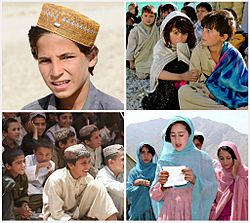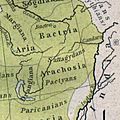Pashtunistan facts for kids
Quick facts for kids
Pashtunistan
پښتونستان
|
|
|---|---|

Pashtun-inhabited regions in green (1980)
|
|
| Countries | |
| Population
(2012)
|
|
| • Total | c. 42–50 million |
| Demographics | |
| • Ethnic groups | Pashtuns |
| • Languages | Pashto Minor: Persian, Urdu, Hindko, Balochi, Ormuri, Parachi, Dardic, Nuristani |
| Time zone | UTC+04:30 and UTC+05:00 |
| Largest cities | |
Pashtunistan (Pashto: پښتونستان, Pax̌tūnistān or Pukhtunistan, meaning the "land of Pashtuns") means the region where the indigenous Pashtun people of modern-day Afghanistan and Pakistan lived.
The native people
The native or indigenous people of Pashtunistan are the Pashtuns (also known as Pakhtuns, Pathans and historically as ethnic Afghans), an Iranic ethnic group. They are the largest ethnic group in Afghanistan and the second largest in Pakistan. The Pashtuns are concentrated mainly in the south and east of Afghanistan but also exist in northern and western parts of the country as a minority group. In Pakistan they are concentrated in the west and northwest, inhabiting mainly Khyber Pakhtunkhwa and northern Balochistan. In addition, communities of Pashtuns are found in other parts of Pakistan such as Sindh, Punjab, Gilgit-Baltistan and in the nation's capital, Islamabad. The main language spoken in the delineated Pashtunistan region is Pashto followed by others such as Balochi, Hindko, Gojri, and Urdu.
The Pashtuns practice Pashtunwali, the indigenous culture of the Pashtuns, and this pre-Islamic identity remains significant for many Pashtuns and is one of the factors that have kept the Pashtunistan issue alive. Although the Pashtuns are politically separated by the Durand Line between Pakistan and Afghanistan, many Pashtun tribes from the FATA area and the adjacent regions of Afghanistan, tend to ignore the border and cross back and forth with relative ease to attend weddings, family functions and take part in the joint tribal councils known as jirgas. Though this was common before the war on terror but after several military operations conducted in FATA, this cross border movement is checked via military and has become very less in comparison to the past.
Depending on the source, the ethnic Pashtuns constitute 42-60% of the population of Afghanistan. In neighboring Pakistan they constitute 15.42 percent of the 200 million population, which does not include Pashtun diaspora in other Pakistani cities and provinces. In the Khyber Pakhtunkhwa Province of Pakistan, Pashto speakers constitute above 73 percent of the population as of 1998.
Images for kids
-
Coronation of Ahmad Shah Durrani in 1747 by a 20th-century Afghan artist, Abdul Ghafoor Breshna.
-
King Amanullah Khan, son of Habibullah Khan and grandson of Abdur Rahman Khan.
-
Bacha Khan (left) with Mahatma Gandhi and Kasturba Gandhi
-
Ayub Khan, President of Pakistan from 1958 to 1969, belonged to the Pashtun Tareen tribe of Haripur.
-
Kalam, Swat District in Khyber Pakhtunkhwa, Pakistan
-
A village in Kunar Province of Afghanistan
-
Nangarhar Province, Afghanistan
-
A village in Khost Province, Afghanistan
-
The shrine of Hassan Abdal in the Arghandab District of Kandahar Province in Afghanistan.
-
Asadabad, capital of Kunar Province in Afghanistan
-
Branches of the Kunar River meet in Nangarhar Province
-
Kabul River in Jalalabad, Afghanistan
-
Khyber Pass in Khyber Pakhtunkhwa, Pakistan
-
People attending Khost University in Khost, Afghanistan
-
Ghazni Province, Afghanistan
-
Afghan Border Police (ABP) in Paktika Province
-
Kuchi people in Paktia Province of Afghanistan
-
Hanna Lake in Quetta, Pakistan
-
Dahla Dam in Kandahar Province
-
Kandahar Province, Afghanistan
-
Helmand River in Helmand Province, Afghanistan
See also
 In Spanish: Pastunistán para niños
In Spanish: Pastunistán para niños


























